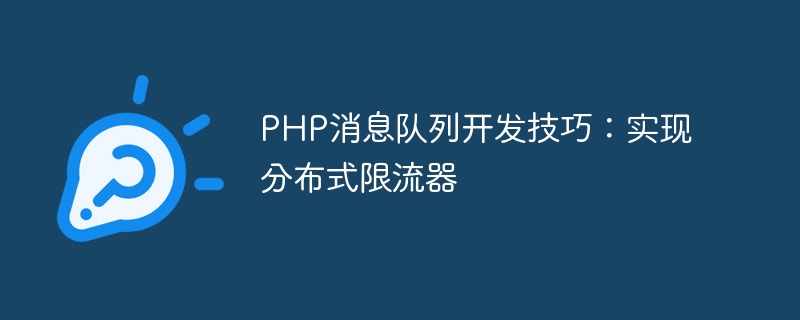Home >Backend Development >PHP Tutorial >PHP message queue development tips: implementing distributed current limiter
PHP message queue development tips: implementing distributed current limiter
- PHPzOriginal
- 2023-09-11 15:05:141015browse

PHP message queue development skills: implementing distributed current limiter
With the rapid development of the Internet, the amount of concurrent access to applications is increasing, which gives System performance poses serious challenges. In the case of high concurrency, in order to ensure the stability and availability of the system, it is necessary to restrict system access to prevent the system from being overwhelmed by too many requests. Distributed Limiter is a mechanism used to control concurrent access to the system. In a distributed environment, message queues are used to implement the current limiter to be more flexible and efficient.
Taking PHP as an example, the following will introduce how to use message queue to implement a distributed current limiter.
First, we need to choose a suitable message queue middleware, such as RabbitMQ or Apache Kafka. These middleware provide an efficient and reliable message passing mechanism and support distributed deployment, making them very suitable for building distributed current limiters.
Next, we need to define a counter to record the current number of visits. This counter can be stored in a cache such as Redis to ensure its efficiency and scalability. During access, we can increment the counter value through atomic operations, and clear the counter value periodically to achieve the expiration effect of the counter.
Then, we need to define a message producer in the message queue to issue access requests. When a request arrives, the message producer will publish the request to the message queue, along with some request-related information, such as the requested IP address, timestamp, etc.
At the same time, a message consumer also needs to be defined in the message queue to handle these access requests. The consumer will get the request from the message queue and determine whether it needs to reject the request based on the relevant information of the request. If the set threshold is exceeded, the request will be rejected, otherwise the request will be accepted and processed.
The strategy for rejecting requests can be selected based on specific business needs. For example, an error code or error message can be returned to the client, or the request can be discarded directly.
In addition, in order to ensure the effect of the distributed current limiter, we also need to add some additional control logic to the message queue to avoid some potential problems. For example, message processing order issues, message loss issues, etc. Distributed locks, ACK mechanisms, and message retries can be used to solve these problems.
Finally, in order to better monitor and manage distributed current limiters, we can use some monitoring tools, such as Prometheus and Grafana, to monitor system access and the working status of the current limiter in real time.
Through the above steps, we can use PHP message queue to implement an efficient and reliable distributed current limiter. This current limiter can help us control the concurrent access of the system and ensure the stability and availability of the system.
In short, with the continuous development of the Internet, distributed current limiters have become an important tool to ensure system stability. Using PHP message queues to implement distributed current limiters can provide better performance and scalability. Through reasonable design and implementation, we can better cope with high concurrent access, thereby improving system performance and user experience.
The above is the detailed content of PHP message queue development tips: implementing distributed current limiter. For more information, please follow other related articles on the PHP Chinese website!

